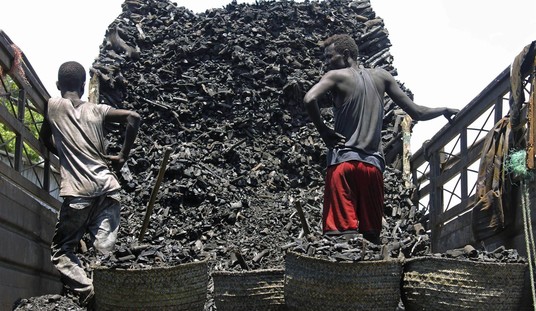Bryan Preston reported earlier today on the 130 US military personnel who have been dispatched to Erbil. Their mission, according to the Obama administration, is to come up with military options to get 30,000 Yazidis off of Mount Sinjar to safety.
The logistics of such an operation would be a nightmare. The Yazidis are spread out over 35 miles on the crest of Mount Sinjar. Any kind of an airlift would have to be accomplished with helicopters — the largest of which could only carry a couple of dozen refugees at a time. The Marines have about 4 V-22 V/STOL Ospreys in Erbil itself, which might also take part in an airlift. But the Ospreys can only carry about 25 passengers. We would almost certainly need the assistance of other nations with V/STOL aircraft and heavy-lift helicopters to get the refugees off the mountain quickly.
Another option is creating a “humanitarian corridor” to take the refugees to safety. The Yazidis would be guided to embarkation areas where they would be transported off the mountain via buses and autos.
But many of the children and oldsters are very weak from hunger and disease. Helping them walk miles across the barren expanse of Mount Sinjar to reach an embarkation point would be a huge operation itself.
The New York Times speculates on how the rescue might play out:
No matter how it is done, getting tens of thousands of Yazidis off Mount Sinjar would be a complicated and dangerous endeavor, Pentagon officials said.
The most direct route off the mountain would be to head south into greater Iraq, but that would take the refugees and any troops protecting them through ISIS territory, increasing the potential for combat and casualties. Passing through the ISIS-held area, one senior military official warned, would also allow the militants to blend into the refugee population, making it more difficult to target them for American airstrikes.
The far more viable option, administration officials and humanitarian experts said, would be to establish a corridor northwest through Syria, following the paths established by the few refugees who have escaped. The refugees would then cross back over the border into Kurdistan.
The route through Syria would require Kurdish pesh merga fighters to make up the bulk of the troop escort, but a second military official said that American Special Operations forces and perhaps even Marines would have to reinforce that effort.
“We would have to thicken our advisory presence in a significant way,” said Hardin Lang, a senior fellow with the Center for American Progress and a former senior adviser to the United Nations special representative to Iraq. But American troops would be unlikely to go into Syria, making that route more complicated.
Another major drawback to the corridor idea is that it would take too long to implement. The Yazidis are hanging on by their fingernails at this point, and the humanitarian aide that’s flowing now is only a stop-gap solution.
Prime Minister David Cameron of the UK has suggested the Great Britain would take part in a rescue operation. Cameron was facing fierce criticism for not doing enough to support the US in its effort to save the refugees. He actually cut short his vacation to come back to deal with the crisis, saying, “I can confirm that detailed plans are now being put in place and are under way and that Britain will play a role in delivering them.”
The Washington Post explains why some US troops would be needed in an evacuation:
Evacuating civilians from the mountainside would likely require at least some U.S. troops on the ground, however. A security perimeter for the aircraft to land would be required, and troops would likely be needed at a nearby airfield, perhaps in Irbil, to coordinate the multiple trips it would take. Additional attack helicopters like the AH-1W Super Cobra also would likely escort the Osprey, which can carry about 24 passengers.
Time Magazine points out some of the drawbacks to a land operation:
Without U.S. boots on the ground, that means any land-rescue effort would probably require at least some non-U.S. military ground forces to keep the forces of the Islamic State of Iraq and Syria (ISIS) away from the rescue operation while it takes place. U.S. airstrikes in recent days have kept ISIS forces at bay, but a massive rescue operation is likely to require ground forces.
But allies won’t go where the U.S. fears to tread, which means only local troops—the Iraqi army or the Kurdish Peshmerga forces—will be available. The Iraqi army collapsed when ISIS stormed Mosul in June, and there is little evidence it has improved since. The Peshmerga are a more likely candidate, but their small arms can’t defeat the U.S.-supplied armor and artillery that ISIS units captured from Iraqi forces in recent months.
Plus, mounting a land-rescue operation may take more time than the stranded Yazidi have. They are being kept alive by airdrops of food and water by the U.S. and other nations. Continuing reports and video footage of dying civilians are likely to compel the Obama Administration to seek a faster rescue option, which would be by air. The U.S. would seek help from other nations in carrying out the risky endeavor.
Once again, such an operation would require allied ground forces to ensure the security of pickup zones, and to help suppress ISIS’s limited, but lethal, anti-aircraft capability.
The Islamic State may decide that they can inflict a blow to US prestige by mounting a major attack against any forces we send to Mount Sinjar. Killing a bunch of Americans and other westerners would be a big propaganda victory for them. Air power would be crucial in protecting our troops and the transports that are carrying refugees off the mountain.
While President Obama has finally bestirred himself to act, there is a danger that he will split the difference and fail to fully support the mission. That, and his historic penchant for taking forever to make a decision does not bode well for the operation. If he is going to act, he must do it decisively and commit himself to the success of the mission, regardless of the political consequences.
I am not confident he is capable of doing that.










Join the conversation as a VIP Member